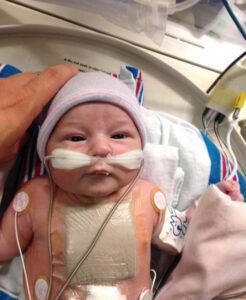Main Street News

Congenital Heart Defect Awareness
February 7th through 14th is Congenital Heart Awareness Week, which recognizes children and adults living with congenital heart defects, celebrates their journeys, and increases public awareness of these heart conditions.
“I gave birth to her, and then she turned blue,” Stacey Burlingame of Stanfordville, NY, said of her first daughter, Olivia. Olivia was born with a congenital heart defect and has already had four open heart surgeries.
She’s nine years old.
What are congenital heart defects (CHDs)?
Congenital heart defects are the most common kind of birth defect and can affect the structure of a baby’s heart and how it works.
According to the CDC, “CHDs can vary from mild (such as a small hole in the heart) to severe (such as missing or poorly formed parts of the heart). About 1 in 4 babies with a heart defect has a critical CHD. Babies with a critical CHD need surgery or other procedures in the first year of life.”
Some CHDs can be diagnosed during pregnancy through fetal echocardiograms, but Olivia’s wasn’t caught until she was born. Sometimes, CHDs aren’t detected until after birth or later on in childhood or even adulthood.
According to the CDC, the causes of CHDs are unknown. “Some babies have heart defects because of changes in their individual genes or chromosomes. CHDs are also thought to be caused by a combination of genes and other factors, such as things in the environment, the mother’s diet, and the mother’s health conditions.”
As medicine continues to advance, children with CHDs are “living longer and healthier lives.” The CDC estimates that there are more than two million people in the United States living with a CHD and that many of them lead independent lives with little or no difficulty.
Olivia’s story 
Olivia was born at Northern Dutchess Hospital in Rhinebeck, NY, and Stacey was told that she wasn’t going to make it. They immediately shipped her down to Vassar Hospital in Poughkeepsie, and she later went to Westchester Medical Center – all in one night.
Olivia was in the NICU for three days before she went in for her first open heart surgery. In that surgery, they opened her pulmonary valve and put a shunt in. The shunt provides a pathway of circulation of blood from the right side to the left side of the heart.
From there, she was sent to Blythedale Children’s Hospital for a week for rehabilitation and to learn how to feed.
Olivia was alive for an entire week before either of her parents got to hold her for the first time. “That’s part of the reason why I was so scared when we had Finley,” Stacey said of their second daughter. “When we had Liv, they just took her. With Finley, they gave her to me and the whole time I was like, ‘Okay, when are you going to take her away?’ It was so weird.”
At three months old, Olivia had her second open heart surgery. For this one, they replaced the shunt and worked on her pulmonary valve once again.
An unexpected surgery came at nine months old. Olivia had fallen off of her parent’s bed backwards and hit her head. She had been on aspirin for her heart, so when she obtained a small fracture in her skull, doctors were worried that she was going to have a brain bleed.
Thus, Olivia went in for brain surgery.
 “Shockingly, that surgery was one of the easiest,” Stacey said. “The heart surgeries always take around eight or ten hours. The brain surgery was only about two.”
“Shockingly, that surgery was one of the easiest,” Stacey said. “The heart surgeries always take around eight or ten hours. The brain surgery was only about two.”
Following the surgery, she lost all movement on her left side. While Stacey and her husband, Roland, were assured that this was normal because the trauma occurred on her right side, they were still afraid.
Olivia’s third surgery came at five years old. “That was the worst one because she didn’t bounce back nearly as quickly as she did for the others.”
She was in the hospital for a week, was very lethargic overall, and wasn’t able to take her medications. “The doctors couldn’t get her to take her meds, even with ice cream,” Stacey recalled. “Finally, one of the nurses tried the meds and realized how bad they tasted. She was like, ‘no, get something else. If I can’t take it, no wonder she can’t keep it down.’”
Olivia ended up with migraines from that procedure, which will likely get worse for her later on in life.
Her most recent procedure was in 2020. For that one, she was out of the hospital within three days from beginning to end. During that procedure, they replaced her pulmonary valve and tightened her tricuspid valve.
“After this last surgery, she came home and was playing with her Barbies and the tee-ball outside, and we were like, ‘Who the hell is this kid?’” Stacey said. “We were expecting the worst because with the surgery before this, she was so exhausted and depressed, and it just took her so much longer to recover.”
Olivia will likely have to go in for an additional surgery at some point, but Stacey is hoping that it won’t be for another few years at least. “She’ll have to go in again to fix the valve leak that she has, but I’m hoping they’ll maybe be able to go in through the ribs for that one so it’s less invasive,” she said. “Medicine has come so far, I’m hoping they’ll be able to make surgery easier on her.”
Life now
You would never know by looking at her that Olivia has been dealing with this for her entire life. She has no restrictions. She goes to school, swims, skis, and rides horses. She spends time playing (and occasionally fighting) with her younger sister, Finley, and their house full of dogs.
Olivia goes to her cardiologist twice a year for a checkup to make sure that everything looks good, and she has to take a stress test once a year.
“She used to turn blue in the winter, but she doesn’t do it as often since the last surgery,” Stacey said. Olivia’s fingers, lips, and ears would tinge blue in the winter because of her poor circulation. Now, however, they send her to school with a heated blanket for when she gets cold.
For all intents and purposes, Olivia gets to live a normal life. “She’s a happy kid. She gets to do all the things that she loves.”



